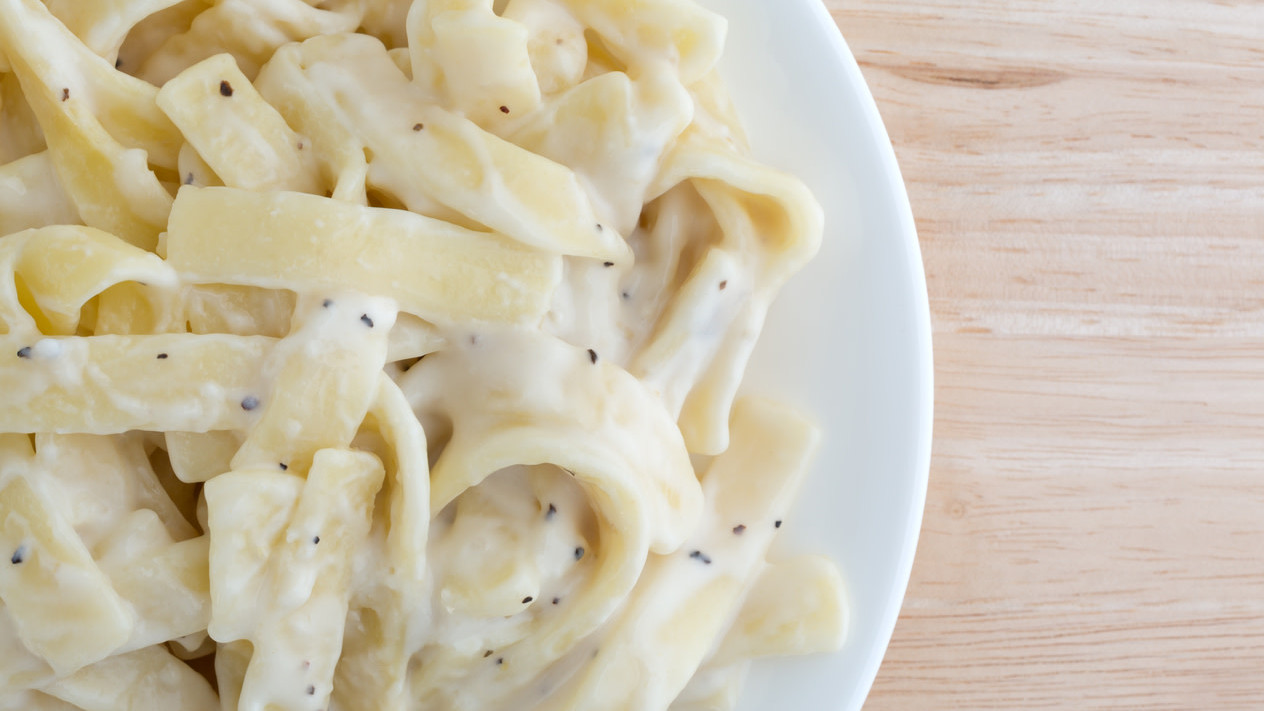You Don't Have To Follow Italy's Rules To Make Great Fettuccine Alfredo
Years ago, a big, burly, gingered chef saw me making fettuccine Alfredo with cream sauce for my shift meal. He said, "You know in Italy they don't use cream, right?" I was indignant. What? What the fuck do they use, then? The only way I knew how to make Alfredo was with cream. But, if you've got a better way, you towering Irish giant, I'd love to hear it. "Butter," he explained, "just butter." I was confused. That didn't sound so much more elegant than what I was doing. Was I somehow diluting Italian culture with the addition of heavy cream? I didn't think so. I still don't. When it comes to regional cuisine, there tends to be an obsession with the notion of "authenticity," and this is doubly true for any aspect of Italian culture. We fetishize Italian nonnas and gleefully watch YouTube videos of real Italian chefs talking shit on bastardized pasta. We love, love to say "the old country." I find conversations about authenticity reductive, and even worse, boring. I'm much more interested in how a dish can evolve and change, rather than rehash the set-in-stone methods that somehow deem that dish more desirable.
The Roman Alfredo that the ginger chef insisted on, called pasta al burro, is just butter and cheese and pasta water. It's simple, as so many actual Italian recipes are. But is it better than what we Americans know as Alfredo? The transformation of fettuccine Alfredo into a wholly American dish, however it happened, is pretty marvelous. Alfredo is now the flagship meal of Italian-American food, probably even above chicken parmigiana. With fettuccine Alfredo, we took something that was Italian, then popularized it and made it something that Italians passionately refute. That's a beautiful transition, if you ask me. (Besides, if I'm going to make an authentic pasta-water-and-cheese sauce, I prefer cacio e pepe. Roman Alfredo is essentially cacio plus butter, and they're just too similar to both have a place in the pasta canon.)
I've got a special place in my heart for slightly gloppy American Alfredo. It's informal and not finicky. It's not complicated, nor does it take a skilled cook to make. It's cream and butter and Parmigiano-Reggiano. It's garlic (a thing tons of Italian food purists will tell you isn't needed). It's cheap, sturdy, store-bought pasta. Oh, and when it comes time to plate, Alfredo serves looks. The silky, ghost-white sauce and noodles look ethereal in presentation. The parsley pops against the minimalist background. Most wonderful, I find, is that this angelic dish has a calorie count that is off the fucking charts. It will kill you if you let your guard down, and I respect the hell out of that.
If you've had bland fettuccine Alfredo, that comes as no surprise. Most of it is bad. Lots of restaurants use roux instead of letting the sauce thicken naturally or with the addition of cheese. Roux, in this process, isn't meant to be flavorful. It's just a cheap way to make big batches of sauce, a thing I guarantee Olive Garden does. The recipe below is a combination of both pasta al burro and fettuccine Alfredo. A cream and garlic base, plus the pasta-water-and-butter technique, join forces to form one super recipe. Still, it's the fettuccine Alfredo we know, the champion of continental, ubiquitous Italian-American dining. Maybe it's not elegant, maybe it's crude—but fuck the haters, I say.

Fettuccine Alfredo
Serves 2
- 1/2 lb. dry, dirt-cheap pasta
- 2 cloves garlic, smashed with the back of a knife
- 1 Tbsp. extra virgin olive oil (or garlic-infused oil)
- 1 cup heavy cream
- 3-4 Tbsp. butter
- 1 Tbsp. crushed red pepper
- 2 Tbsp. parsley
- Salt and white pepper to taste
- 1 cup Parmiganio-Reggiano, grated
- 1/4 cup pasta water
In a heavily salted pot of boiling water, throw in the 1/2 pound of pasta and cook until firm. Save 1/4 cup of the pasta water and strain the pasta. I recommend cooking the pasta and the sauce at the same time, but if that's too much multitasking, go ahead and rinse the pasta under a little cold water to stop the cooking process. It's okay to leave in a strainer while you make the sauce.In a skillet on medium heat, add the olive oil and crushed garlic. Cook for 2 minutes until fragrant. Add the crushed red pepper. Cook another minute or until the garlic is slightly golden. Add the heavy cream and bring to a simmer. Stir every so often with a rubber spatula. Let it thicken a bit, being sure not to boil, and once it's hot, add 1 tablespoon of butter and swirl. Add salt and pepper to taste. Next, add the grated parm a few tablespoons at a time until the sauce thickens to a viscosity that will coat the pasta.
Add the pasta to the skillet. Stir everything around (it should sound thick and gross) and continue to add a little bit of pasta water and butter in revolutions. When it gets thick, add some water. When it feels thin, add some butter and a little cheese. The pasta will continue to cook while you do this. Continue doing this for another 2-3 minutes and you should have a sexy-looking fettuccine. Salt and pepper once more.
Serve in a dark bowl with parsley and more grated parm. Really let it pop. Also check out my Instagram story highlights (@palumbros) if you're into seeing the POV process.
